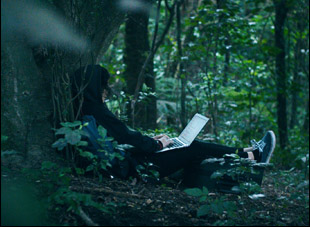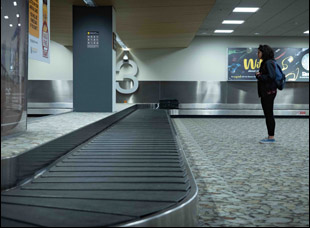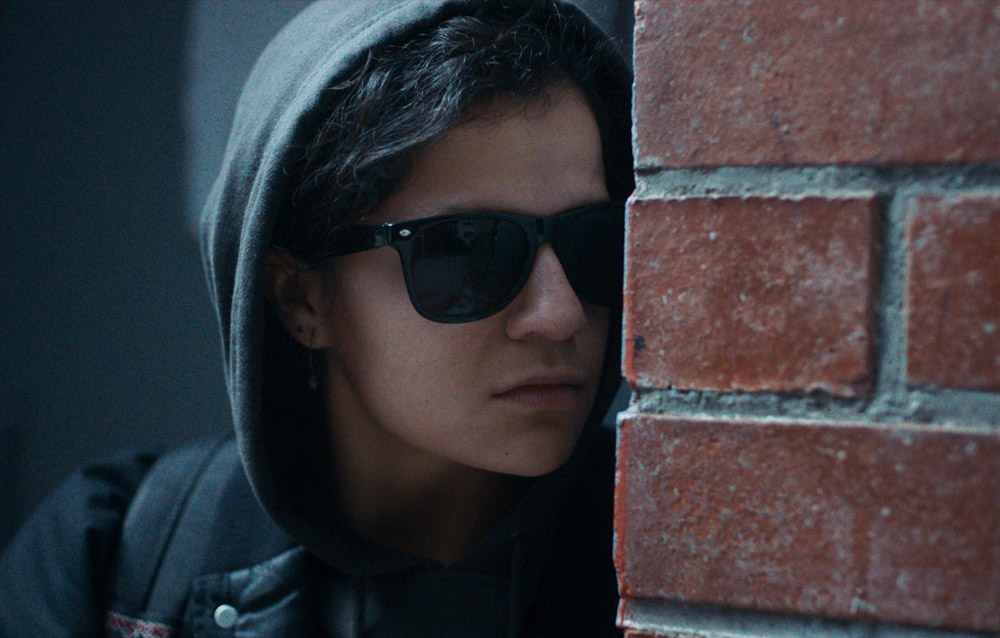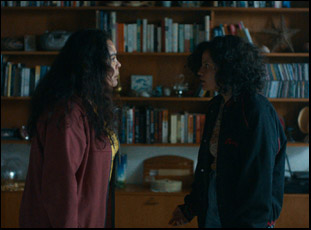“I just got dumped by my future,” Millie (Ana Scotney) confides in her former professor Scott (Sam Cotton), one of the few to know she’s still in New Zealand after she backed out of a flight to New York at the last second in “Millie Lies Low.” The architecture student had become the literal face of the school she left behind, a success story touted on the billboard that sits above her at the Wellington Airport, but though she’ll insist to anyone that will listen that she doesn’t experience panic attacks, she becomes suspiciously short of breath on the plane before it can leave the gates, pushing past flight attendants to try to make her way past the sealed doors. Scott doesn’t only lend a sympathetic ear, but being just outside of her age-appropriate social circle also is one of the few she doesn’t feel ashamed in front of, assuming a presence like a ghost in her old haunts where she goes incognito to a costume party where her boyfriend Henry (Chris Aloiso) and her bestie Carolyn (Jillian Nguyen) speak freely about her when they think she’s a world away and continues to follow them on social media where she builds up a narrative in her head based on the specious evidence that photos and celebratory captions can provide.
If anyone has a full picture in “Millie Lies Low,” it’s director Michelle Savill, who working with co-writer Eli Kent, crafts a cringe-inducing comedy that doubles as an insightful character study of its lead experiencing a quarter-life crisis, with the paralysis she’s feeling as a result of self-doubt manifesting itself in the physical world when she can’t return to the place of her past as herself but also has no obvious way forward. Despite Scott offering a place to stay, it still doesn’t relieve the burden on Millie of being stuck in her own skin and Savill finds a unique way in to speaking to the pressures of living in an era in which everyone’s lives can be curated to appear so successful when things might actually be crumbling from within and ideas of success itself can vary so significantly from one person to another. Apart from a spirited performance from Scotney, who is able to show the full range of her talents that have been glimpsed from her dramatic turn in “Cousins” to the anarchic scene-stealing of “The Breaker Upperers,” the film impressively brings an abstract and potentially cinema-averse subject into focus, turning Millie’s anxiety into a propulsive energy.
After premiering at Berlinale and making its North American debut at SXSW last year, “Millie Lies Low” is starting its theatrical run in the States this week and Savill, who has already starting seeing the fruits of her labor as a director on the next season of Netflix’s “Sex Education,” reflected on the making of her charming feature debut, completing it against all odds after having to shut it down when the COVID pandemic first sent the world into lockdown and emerging with something to be proud of.
I was going to a festival in France with a short film I made, “Ellen is Leaving” and I missed my flight, which is really unlike me and I just had a bit of a meltdown. I was told I’d have to buy a whole new ticket and it was $3,000, money I didn’t have, so I just thought, I’m going to have to pretend I’m in France for three weeks because I’ve told everyone I’m going. I had this terrible night of not knowing what to do and people thinking that the flight had left, and the next morning I tried again and got a different counter attendant who took pity on me and put me on that day’s flight, but if I hadn’t have gotten her, I don’t know what I would have done.
That became the kernel for what if someone really did pretend that they had moved overseas, what kind of person would do that and why would they do that and where would that lie take them? There was a sense of shame and loss of face that I felt about that. And I wondered why I felt so deeply embarrassed for what had happened. And then there were elements of [my own background from] growing up in the Philippines as a missionary kid, and there’s a big loss of face in that culture, so I brought that over into it as well and just began exploring all these aspects and they eventually became intertwined into this film.
What sold you on Ana Scotney to play Millie?
I had met her when she was at drama school in Wellington, which was where I was living and where the film was shot, so I’d had my eye on her for a few years and thought she was amazing, but we still did a really wide casting call across Aotearoa, New Zealand. We did a lot of callbacks and it just became really clear that she was right for Millie. She had the physicality that I was looking for and the ability to do both drama and comedy. She was also a lovely, grounded and warm actor, which I needed as well and I worked a lot with Ana in terms of l developing Millie further.
She had some ideas and I was always open to dialogue changes and what she [thinks she] would say as a character, so that informed the script. And of course, Ana is of a Māori or Tuhoe background, and so is Rachel House, and I’m Pākehā or a white New Zealander, so there was an invitation for them to bring in their own indigenous background into the characters which I hadn’t written in and couldn’t because I’m not indigenous, so they were [all] able to bring what felt real for them into their characters and into the story.

Yeah, it was and for a while, it was something I was trying to resist, like I want as few phones as possible. But I quickly realized this is a contemporary film and I’m trying to accurately portray what it might be like for someone who does this and needs to pretend, so a huge part of that is texting and Skyping because it was pre-pandemic that we started shooting this, so tI decided I’m just going to embrace all the technology as much as possible, but keep it real and in camera. We did all the Skype calls and all the texting in camera, and it was really interesting how much personality can come through how someone types a message, like how they move their fingers and their thumbs. I started to really appreciate the subtleties in actually using technology.
Was the shoot divided by the pandemic?
Yeah, we got shut down in the first wave of COVID that hit New Zealand and we were only on day four of filming. Then it took another six months before we could get it back up and get into it, and during that time, I couldn’t work on it or really look at it because I was so heartbroken, having taken years to get it up, just to have it fall over. But then I started looking at the footage and we cut the very few scenes we had shot. And it just became clear that a lot of the film was going to be on Millie’s face, in mids and close-ups and we got a bit of a rhythm of holding on longer shots [in the edit], and then occasionally jump cutting, so we were able to review what footage we had and it just made us confident in what we were shooting.
You wouldn’t be able to tell now. Did the ideas about lighting change? It has a really evocative color palette.
No, that was there from the start in terms of the tones of it — the kind of blue wash, but at the same time it’s still colorful and has a grittiness to the look. Andrew Stroud, the DOP, and I had done a lot of research, watching hundreds of films and experimenting with the camera and lenses and going into the grade, all before we shot to figure out what exactly the look was. And again, that footage we shot in that first three days, once we had those scenes edited, we sent it to our colorist and she graded them and played around with them. And we [thought] we’re definitely on the right track.

That was shot in Wellington International Airport, and they were always supportive of this film. We approached them a couple of years before we ended up filming, and they were keen to show the airport and to show Wellington, so pandemic or not, we had their support and backing and they gave us incredible access to the space. We’re just so grateful for their partnership with us.
You also have a great score that brings out the humor and the tension with its pitter patter. What was it like to put music on this?
We worked with a wonderful composer based in Melbourne, and they’re called Evelyn Ida Morris and I just saw their work in another feature a few years before, and the music was so beautiful and I sent them a short film I had and said, “Look, here’s my short. Would you be interested in working on my feature?” And they were interested. And then right from the beginning, my editor would start sending them some of the cut-together scenes so they could start to feel the character and they want to really sit with the footage, get to know the characters, and then see what comes out of them, so we didn’t really know if the music was going to be more orchestral in feel. They tried a bunch of things in the edit and we had lots of discussions and ended up going, quite a percussive route in the end, but I love the music in this film. What they composed, I think is incredible, and I’m just so grateful that they came onto the project.

It just came to life more than I could have hoped for. The locations opening up to us, the [heads of departments] that joined the team and made themselves available and worked on the film, all of them just brought it to life beyond what I could have hoped for and we just became a really tight little family working through it. It was hard work and it was relatively low budget, but we just gave it our all and I’m so proud of what we achieved. And when we finally got it in the can after the second shoot, I was just so relieved because I learned that a film can fall over at any time for reasons you could never have imagined, so that last day of shoot was just a great relief.
And then obviously terror once it came to get it out into the world, not knowing how people would respond to it. But I went to a bunch of festivals with it last year and the audience reaction has just been awesome. The amount of people that have written or come up and talk to me after they’ve seen the film and shared their own incredible stories of embarrassing things they did has just been amazing. I’ve spoken to a lot of people who see themselves in Millie and it’s been a terrific result.
Is there a particularly crazy story you’ve heard?
It is more common than I even thought — just people who pretended their marriages were still going, that they were going to a job they’d been fired from, or, like in this scenario, they had moved [other] countries. I had a guy tell me that they pretended to move to the UK, but head out in another small town in New Zealand for a couple of weeks until his mom called him and said, “I know you’re not in London.” It’s just been unbelievable, even smaller stories of people [called by the] wrong name and they don’t correct them. Months later, they’re still being called Tom when their name’s Dave and then it comes up in a meeting. It’s really embarrassing. There’s just been so many stories like this that people have told me and it’s really blown my mind.
“Millie Lies Low” opens on June 30th in New York at the Quad Cinema and July 7th in Los Angeles at the Monica Film Center.





